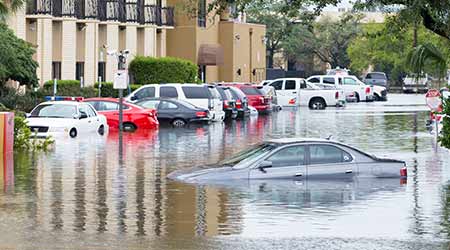« Back to Facilities Management IAQ Category Home
Five Key Best Practices for Mold Remediation after Water Damage
January 16, 2019
- IAQ
By Steve Bouzan
Damage caused by high winds and catastrophic flooding from Hurricane Michael, a near Category 5 storm, underscores the power of Mother Nature to wreak havoc on our communities. According to Florida Gov. Rick Scott, Michael was the “worst storm the Florida Panhandle has seen in 100 years.” https://weather.com/storms/hurricane/news/2018-10-10-hurricane-michael-impacts-florida-gulf-coast While the immediate impact of any natural disaster is obvious — trees uprooted, roofs blown off, power lines down — the damage that can be harder to see has the potential to be even more devastating. Mold caused by water damage can be the source of significant health concerns, long after the high winds of a hurricane have subsided. Understanding the potential effects of mold and best practices for remediation is a critical next step in the aftermath of a natural disaster.
When faced with water damage, it is first important to identify the category of water, as defined by the Institute of Inspection Cleaning and Restoration Certification (IICRC) S500 and S520 standards, and be aware of the associated health effects to update emergency personnel when they arrive onsite.
• Category I: Sanitary Water Source – Originates from a source that does not pose substantial harm to humans including water supply line, tub or sink overflow, melting ice, or falling rainwater.
• Category II: Significant Contamination – Has the potential to cause discomfort or sickness including dishwater or washing machine, toilet bowl overflow, or an aquarium.
• Category III: Grossly Contaminated – Contains pathogenic agents and is grossly unsanitary including sewage, toilet drain backflow, sea water, rivers and streams, or ground water. Viruses including rotavirus, Hepatitis A and B and the Norwalk virus are common in Category III water.
No matter what category of water, microorganisms or mold are always present in an indoor environment and can create significant health concerns for people who have allergies or respiratory issues and cause illness. Controlling the moisture within an affected area is key to controlling mold.
Once moisture is introduced, these microorganisms begin to thrive on food sources — organic, cellulosic materials such as drywall, wood wall studs, wallpaper, hardwood flooring, and more. Most molds will continue to flourish between 60 and 80 degrees F and amplify after 48 to 72 hours, even after the introduction of Category 1 “clean” water. Left unattended, these microorganisms will lead to gross contamination. As a result, responding immediately to water damage will significantly reduce the level of contamination and cost associated with remediation.
The IICRC outlines five key principles of effective mold remediation to ensure swift and effective removal for the safety of all involved:
1. Provide for the health and safety of workers and occupants. Distribute full personal protective equipment including suits, masks and nitrile gloves and offer post-exposure evaluations and follow-up with medical personnel, as needed.
• Prevent cross contamination — airborne hazards traveling from affected areas to otherwise unaffected areas of the building — by setting up containments and critical barriers using 6 mil plastic.
• Utilize HEPA-filtered negative air machines. HEPA filters capture 99.97 percent of airborne particulates at .3 microns in size.
2. Document the conditions and work processes. Because much of the contamination is unseen until remediation begins, photographs, videos, and communication of findings is critical to comprehensive removal.
3. Correct the moisture problem. Once the moisture is controlled, the mold will be controlled. To expedite the drying process, adhere to four key principles:
• Removal of excess water.
• Evaporation.
• Dehumidification
• Temperature control
4. Isolate and control the contaminant at its source, prior to removal. Applying self-adhesive film directly over visible growth will minimize airborne particulates once disturbed and minimize additional contamination.
5. Physically, safely remove and dispose of the contamination. There is no silver bullet to “killing” mold. Even seemingly “dead” mold has potential to release spores which may affect occupants’ health. As a result, it is important to demolish and remove porous materials such as sheetrock, with active growth 2 feet past the last visible point of contamination. Even after demo takes place, mold spores have likely settled. Execute a HEPA “sandwich” of remaining surfaces: HEPA vacuum, damp wipe, HEPA vacuum.
Once remediation is complete it is important to conduct a post-remediation sampling to assess effectiveness, provide a risk assessment for re-occupancy, and address any liability issues. Working in tandem with a restoration partner is helpful to ensure the mold issue is effectively remediated and safe for residents and employees. This partnership creates an important check and balance system and protects you from litigation.
Addressing water damage is a significant undertaking in the wake of a natural disaster, but the very likely presence of mold in tandem requires additional remediation best practices to ensure swift removal. These best practices should serve as the basis for mold remediation within an overall strategic disaster plan, designed to arm facility managers with the strategies, tactics, and critical information needed to respond to all disaster related emergencies in a timely manner.
Steve Bouzan is the director of training and safety at ARS Restoration Specialists.








